You might have heard about LED grow lights a lot in a garden.
But do LED grow lights work in real?
We will be finding this out in today’s guide.
Previously when the technology was not that advanced, there were not many options available for grow lights for an indoor gardener.
However, nowadays, there are tons of options available with the “grow light” term. But expert growers, professionals, and even commercial growers recommend using LED grow lamps.
But why?
Are they good, or is it all hype?
Let’s find out:
What Are LED Grow Lights?
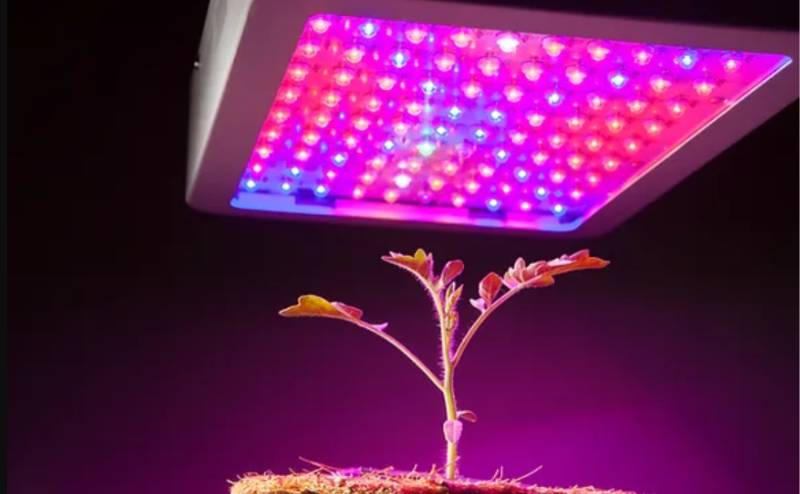
We all know plants use the photosynthesis process to thrive under natural sunlight.
But what when you grow a plant in an indoor garden, and there is no exposure to sunlight?
It is where grow lights come into play and work as a replacement for the natural sunlight.
However, there are several grow lights available in the market:
- Fluorescent
- HPS lights/HID
- LED
We will focus more on LED grow lights today.
LED or Light Emitting Diodes are currently the most efficient, power-saving, and affordably grow lights for growing plants.
The latest LED grow light technology makes it consume less power, produces less heat, and produces more output with full-spectrum rays, which works as same as natural light to trigger photosynthesis in plants.
LEDs emit light in a specific range, allowing your plants to get only those light rays they need for growth and producing yield and nothing else.
That means you can also manipulate the light output according to the growth stage of your plant, and thus you can provide exactly the lighting that is needed the most for that growth stage.
In this way, you can also achieve faster success in indoor gardening.
Also, with the latest LED technology becoming more common in this industry, multiple brands are offering affordable, cheap and quality LED grow lights that work excellently for an indoor garden.
Why LED Grow Lights Are Popular Nowadays?
Now you have a brief overview of the LED grow lights. Let’s look closely at why there is the hype about the LED grow light.
As a grower, you might have heard or read multiple times about LED grow lights from another grower or an indoor gardener.
That means it is quite popular. But there are several reasons for that, some of which I mentioned earlier:
Energy Saving Capacity
One of the major benefits of using a LED grow light is its energy efficiency.
It has an energy-saving capacity, which consumes less power. It is why LEDs also save money on electricity bills.
A quality LED light only provides light output in the wavelength range plants need. Thus, the energy consumed is not wasted to produce non-useful light.
Therefore, it saves energy and also money.
On the other hand, some grow lights like HID lamps produce a lot of yellow and green wavelengths, which the plants do not use, and the energy used for producing that wavelength range goes into vain.
Therefore, one reason LED grow lights have become popular among growers is their energy-saving capacity, which saves a lot of energy and produces the required output.
Better Light Spectrum
LED grow lights provide full spectrum light output, which is all you need for your plants to grow healthy and happy.
Whether blue, red, UV, or IR, you are getting better light spectrum and output from LEDs, saving energy. On the other hand, this is why more growers are opting for LED grow lights.
Hence, the LED grow lights available in the market provide the exact light spectrum they need to thrive, thus making themselves the best replacement for natural sunlight.
Better Heat Dissipation
LED bulbs combined with the latest technology to produce less heat causes it easier to handle and less need for temperature control.
Ultimately, this makes the grow lights safer because they will cause fewer fire hazards.
That means when you put these LED grow lights inside a grow tent or room; you are more likely to be safe when you keep the lights on for most of the day.
It is because most of the cheap quality grow lights, when kept on for a longer period, are used to get heat up a lot and even cause fires sometimes.
However, LEDs are made for better heat dissipation; therefore, they are much safer than other options.
Longer Life Span
LED grow lights have multiple benefits, but you need to invest initially in a good quality LED grow light.
However, with a one-time investment, you get the most out of it. Thanks to the longer life span of LEDs.
LED grow lights have a longer service life than other lights. It is because of the inbuilt engineered components that keep them working for a longer time.
Also, growers report that the LED grow lights used by Samsung diodes have even more service life.
Therefore, using LED grow lights allows the growers to have multiple harvests with a single time investment.
Healthy Growth Of The Plants
Doesn’t matter how much a LED grow light can have features; the ultimate benefit will only be seen when the plants grow healthier to produce impressive yield.
And not to mention, plants under LED grow light grow beautifully. However, due to the wide range of spectrum choices in LED, it becomes easier to provide exactly what your plants need.
Therefore, you can quickly select a specific type of LED grow light, provide near-to-ideal conditions to the growing plants indoors, and have better output from your garden.
This is as simple as that.
Growers tend to have one of the highest yields indoors with LED grow lights.
How Do LED Grow Lights Work?
Now you know that a grow light is electronic equipment that mimics the natural sunlight and provides the lighting conditions your plants need the most for photosynthesis and growth.
Therefore, before you can dive deep into the working of LED grow lights, let’s explore the photosynthesis process again to find out why LED grow lights are the best replacement for natural sunlight.
Photosynthesis Working In Plants
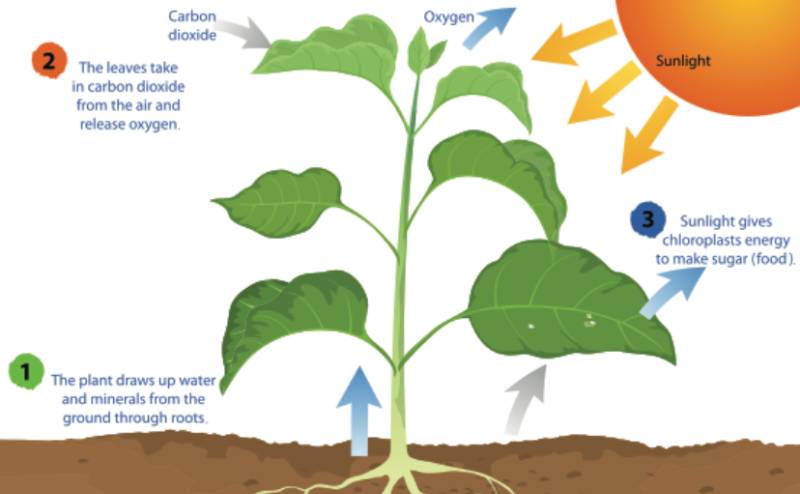
Plants depend on natural sunlight for photosynthesis. In this process, plants utilize the energy of sunlight to create their food.
The chloroplast participates in photosynthesis, which stays under the plant’s leaves.
So, it is how photosynthesis makes use of natural sunlight:
- The plant’s chloroplasts absorb only specific light energy from sunlight; the pigments inside the plants are where it all happens.
- The inside energy absorption and making food for the plants use carbon dioxide to make carbohydrates and thus produce oxygen.
- Through this process, it is clear that the plants use specific necessary parts of sunlight, and only that part participates in making food for the plants.
Now with the help of this knowledge, the light manufacturers and engineers have used the latest technology to build and develop different types of grow lights that can produce an output of a chosen spectrum.
And this spectrum from the LED grow light will be of the highest quality and light intensity, making the plant grow faster and healthier.
However, there are also some grow lights that exactly mimic the natural sunlight and can provide all the spectrums that you need.
But if you need a grow light that can produce a specific spectrum of light to trigger plant growth, or you need a grow light according to different growth stages, then such LED grow lights are available.
Therefore, you will have exactly what you need if you need a specific grow light or a simple grow light that can provide nearly natural sunlight output.
All thanks to the latest tech evolution and LED grow lights.
Working Of LED Grow Lights
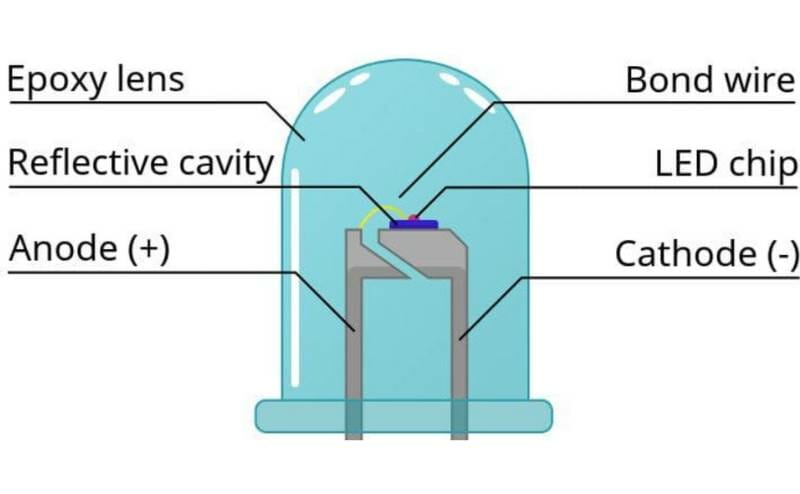
Now you know how plants use natural sunlight to make food and grow faster.
Therefore, it is the perfect time to dive deep and jump into the working of LED grow lights.
Light Emitting Diodes have small electronic components made of semiconductor material.
This semiconductor material has a positive charge (also known as a hole) and a negative charge (also known as electrons).
A semiconductor and electroluminescence are also used in making LED lights to produce light output.
Additionally, in the advanced LEDs, some reflectors amplify the light and make it focus better.
However, these reflectors should be made of better quality as an increase in light can increase the temperature, leading to fire hazards.
Therefore, in high-quality LED grow lights, you will find a better reflector and, thus, better protection from fire.
Coming to the working LED, the electric current begins flowing through the circuit when a voltage is applied to LED, which makes the holes and electrons collide.
This collision of electrons and holes releases the energy through it and thus forms light output.
With the advancement of technologies nowadays, LED grow lights can also produce ultraviolet, infrared, and visible light.
Most plants in their initial growth stage use blue and red grow lights. And adding other colors like green, deep blue, and far red helps in the process and makes them healthier.
It is how the different light spectrum helps plant growth:
- Blue Light: the blue light stimulates the opening of stomata – the tiniest openings on the plant leaves that grab the light into it. Also, blue light helps in the growth of thicker leaves.
- Red light: red light can help more in the flowering stage of the plant. It also helps make plants grow taller but have a stretched appearance and smaller leaves.
- Green light: usually, green light is the least efficient for photosynthesis. However, it is useful for deep penetration of the lighting into the leaf.
Therefore, green light helps lower the leaves of the plant to photosynthesize.
- Yellow light: just like green, yellow light is not that much required for plants in case of photosynthesis; however, still, some plants may absorb it.
- Ultraviolet (UV) light: UV light helps plant growth. UV light enhances leaf coloration, especially in plants with purple-colored leaves.
So, these are the light spectrum that plants use the most. However, growers mostly focus on the blue, red, UV, and (IR) infrared light spectrum as plants are more likely to use these lights.
Therefore, even the latest LED grow lights available in the market are more likely to have only these light spectrums.
LED Grow Light Vs. Natural Light [The Truth]
No doubt, natural sunlight is the best way to grow your plants under. However, it is also true that when you grow plants indoors, there is no better replacement than using an LED grow light.
With the latest tech advancements, LED grow lights almost mimic natural sunlight. Additionally, you can manipulate the lighting according to the growth stage to get the most out of it.
For instance, growers nowadays prefer blue, red, UV, and IR spectrum LED grow lights more as they are more likely to participate in helping plants grow.
However, suppose you are growing in outdoor conditions under natural sunlight. In that case, you must consider other factors, such as windburn, temperature control, moisture control, and many others.
But the ultimate truth is that LED grow lights and natural sunlight work equally to help your plant grow.
LED grow lights have a plus point: you can provide a specific light spectrum according to their growth stage.
It is why LED grow lights are the best replacement for natural sunlight.
Therefore, in the end, it all depends on you as a grower whether you want to grow under sunlight or LED grow lights.
It is because both methods work excellently and have their perks of growing in both situations.
LED Vs. HID And Fluorescent Light
Besides LED lights, HID and Fluorescent lights are available in the market as indoor grow light options.
But fluorescent lights are not a good light source for large plants; however, when using them, you need to put lights above your plants for better output.
On the other hand, HID or HPS lights or High-Intensity Discharge Lights include high-pressure sodium (HPS) and metal halide.
Traditionally, these lights are used in large light areas like warehouses, parking lots, and gyms. However, specialized HID lights are used for growing plants indoors but are not as efficient or good as LED.
Above all these types, LEDs use advanced semiconductor technology for light output, which uses very little power to produce a high output. Therefore, they are the best among all the types of grow lights for indoor gardens.
Overall, LED wins the race if you want to invest in a high-quality indoor grow light. LEDs are way more efficient, powerful, and easy to use than other options.
Therefore, whether you are starting your journey as an indoor grower or want to level up your gardening journey, have a high-quality LED grow light, and you are good to go.
How To Use LED Grow Lights?
As of now, you already know that LED grow lights mimic natural sunlight and can provide almost sunlight the output to the plants.
However, once you buy LED grow lights, it is time to set them up for the maximum output from your grow lights.
So, let’s have a look at how you can use the LED grow lights for maximum benefit:
Setting Up LED Grow Lights?
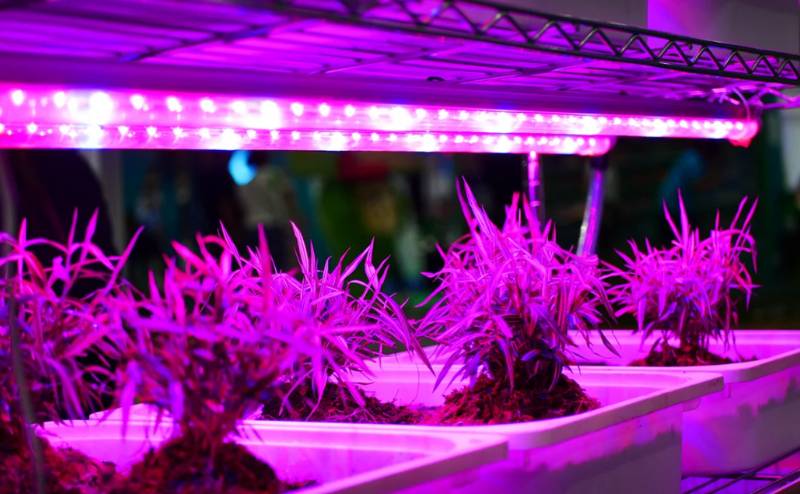
Before setting up LED grow lights, you need to set up your garden first. Then, get a grow tent, or grow box, or make your garage or room a grow area where you can put plants.
Now, once you have set up, the grow space, you need to put your containers in. To make your grow-light work as the sunlight from above, put your LED grow lights above the plants.
Remember to put your LED grow lights perfectly at a specific height.
It is because keeping your grow lights too near to the plants may give light burn to your plants.
Therefore, ensure your LED grow lights are about 12 inches above the plants. Then, adjust the grow lights accordingly and keep them at an appropriate distance.
Once you have set up your lights at the appropriate distance, you can go ahead.
LED Grow Light Maintenance
After setting up LED grow lights, you also need to maintain them.
You need to clean and dust every week or so. Also, moths and bugs are more likely to get attracted to the lights.
If the bugs die due to light, they can hinder the amount of light your plants are getting. Therefore, cleaning the lights will ensure that your plants get maximum light.
LED Grow Lights Cost
The cost of an LED grow light depends upon the size of the light, wattage, features, and other factors.
But on average, LED grow light costs around $300 to $1000.
The cost of the light may be expensive, but the good part about LED grow light is that they last longer.
On average, if you buy a high-quality LED grow light, they need to be changed only after 5 years.
With a one-time good investment, you can have multiple harvests.
Also, LED grow lights put less pressure on your electricity bill as they consume less power. Typically, a LED grow light costs $8 a month.
Compared to the HID lights, which cost more than $30 to run for a month, you save a lot of money with LED grow lights.
It is just like having a Netflix subscription! But you can have more fun with the yield, though!
However, if you are a budget grower, you can look for several LED grow lights available under budget pricing.
Even great quality LED grow lights are available for under $100.
What Are Full-Spectrum LED Grow Lights?
A spectrum in which all colors are included is called full spectrum light. Also, full spectrum LED grow lights mostly resemble the sunlight.
That means LED grow lights with full spectrum output mimic sunlight and illuminate to produce sunlight-like output, which is necessary for plant growth and high yield.
However, to grow plants, growers prefer lights according to their needs. So, for example, if you, as a grower, need to provide light in the flowering or vegetative stage, you need a specific spectrum of light output.
Therefore, you can buy LED grow lights according to your need.
However, if you use a full spectrum LED grow light, you are completely good to go for all the different growth stages of the plant.
A full-spectrum light will spare you from buying different grow lights illuminating different spectra.
Therefore, whenever you buy a grow light, buy full-spectrum until or unless you don’t want a specific type of light for a particular plant growth stage.
What Are The Best LED Grow Lights Available In The Market Right Now?
I will name three best quality LED grow lights that are available currently in the market at a great price:
3. Vivosun VS1000 – Best Budget-Friendly

With high-quality Samsung LM301 diodes, Vivosun VS1000 is one of the best LED grow lights on the market. At a budget price segment, you get LED light that has years of service life and can give you impressive yield. Check 4.5/5.0 rating from 2500+ reviews
2. Spider Farmer SF1000 LED Grow Light – 1000W Premium Grow Light

One of the most reputed brands in LED grow lights; Spider Farmer SF1000 LED grow lights provide you 3 x 3 ft. coverage with a 1000W diode layout. Get full spectrum output with the Samsung diodes. Ideal for all growth stages, this LED grow light is all that you need for a successful harvest every time.
1. Mars Hydro FC4800 Grow Light – Best Grow Light For 4 x 4 ft. Grow Tent
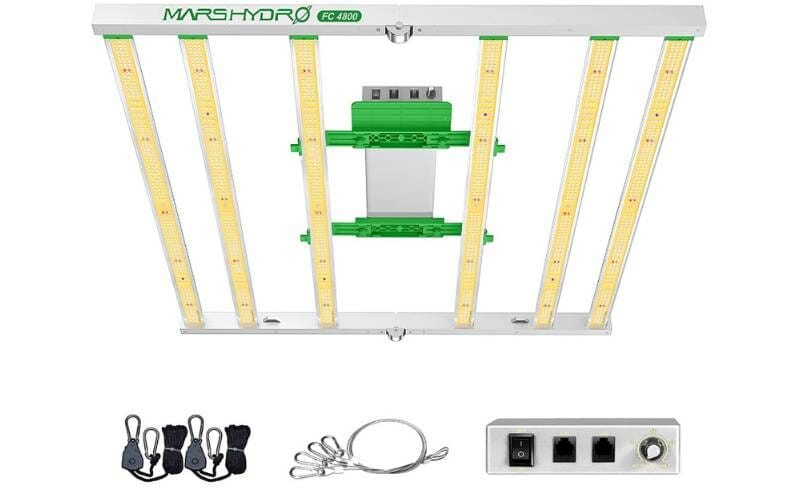
Whether a newbie or a pro grower, Mars Hydro FC4800 grow light is built for true indoor growers. It comes with 1680 pcs of LEDs with 6 bars. The daisy chain dimmable light is perfect for a 4 x 4 ft. grow tent and can make you maximize your garden’s yield.
Pros And Cons Of Using A LED Grow Light
Let’s have a quick look at the pros and cons of using LED grow lights:
Pros:
- LED lights are highly efficient; therefore, they consume less power to generate high output
- LED lights have a longer life span; they only need to be changed after around 5 years
- LED lights need to be less managed
- They are easy to use
- Have full spectrum light output
Cons:
- LED lights are highly costly
- LED lights of cheap quality may cause fire
FAQs
Do LED lights work to grow plants?
Yes, LED grow lights work to grow plants. They are built with the latest technology that produces the almost sunlight-like light output; therefore, they can provide the lighting your plants need the most for thriving.
Therefore, LED grow lights work to grow plants.
Are LED lights as good as grow lights?
LED lights are the latest innovation when it comes to growing lights. They are of high-quality electronic components and therefore currently the best in the market.
How long should LED grow lights be on?
Grow lights must be effective for at least 8 to 10 hours daily. It can vary up to 16 hours daily, depending on the conditions.
Nowadays, LED grow lights are also coming with the latest timer technology, under which you can time your lights on and off for a specific time duration.
Can a white LED lights be used as a grow light?
White LED lights are a good mix of different wavelengths that plants need. Therefore, they should be good to be used as a grow light for a plant.
However, regular LED grow lights typically don’t have sufficient light output or power to help plants flower; therefore, you need to check your need accordingly.
Do indoor grow lights work?
Yes, indoor grow lights work, especially once you know the right grow light to put in. Therefore, you need to research well and buy high-quality LED grow lights that you can use for your plants.
Vivosun, Mars Hydro, and Spider Farmer are some of the top brands that work excellently as indoor grow lights.
Conclusion
Finally, now you know how light-emitting diode light functions and can help you achieve faster success and growth in indoor gardening.
From a full spectrum light system to Samsung diodes, you know exactly what makes a grow light – a quality LED grow light.
Hopefully, now you will be able to make better decisions regarding LED grow lights. Read our 15+ Best LED Grow Lights guide if you need proper guidance.
Until then, happy growing!
